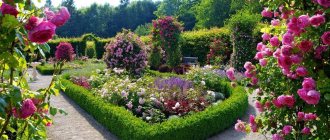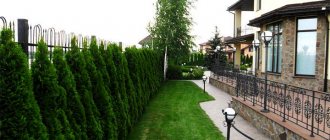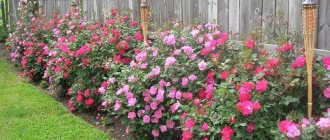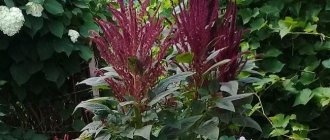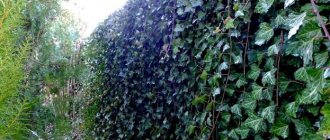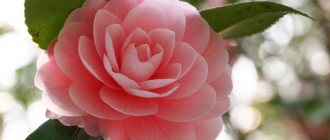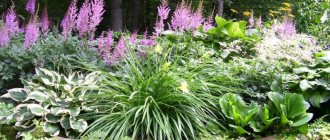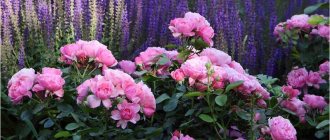Almost no dacha is complete without a fence. Bright flower beds can disguise an unsightly fence or emphasize its sophistication. If you properly organize the arrangement of plants, the space along the fence will look impressive all season long.
In this article we will tell you how to create a beautiful flower bed along a fence, what annuals and perennials are suitable for this, and what procedures you will have to regularly carry out so that the flower garden does not lose its attractiveness.
Where to start arranging a flower bed
First, decide what you want the future flowerbed to look like. It happens that one desire or idea is not enough to end up with a flower garden that will delight you with color and harmony. Plants may shade each other, or may not take root in a shady place, or “not become friends” with each other. There may be many such reasons, but the result is always the same - you won’t get a beautiful flowerbed.
What to consider when creating a flower bed along a fence:
- Flowerbed area . At the design stage of the future flower garden, decide on the territory that you will allocate for the flower bed. If it is a narrow strip of land, one type of small plant is usually planted. If the flowerbed turns out to be long and its width is about a meter, select two or three varieties of flowers and shrubs. If you plan to set up a fairly wide mixborder near the fence, you will need more plants.
- The purpose of the flowerbed . If you want to hide an unsightly fence or “camouflage” yourself from the prying eyes of neighbors, taller or climbing plants are suitable. And if you are creating a flower bed for your own aesthetic pleasure or to emphasize the attractiveness of a hedge, you can choose low but bright plants.
- Flowerbed location . Light-loving and drought-resistant plants are planted on the southern and western sides, and those crops that easily tolerate cold and shading are planted on the northern and eastern sides.
- Plant preferences . In one flower bed it is better to place plants that are equally demanding of watering, soil, sunlight and fertilizing. Then it will be easier to care for such plants.
- The height of the fence and its material . If it is a high continuous fence, the most unpretentious crops will have to be planted. If the fence is metal, keep in mind that in the summer it will get very hot, so you should move the plants a little away from it. If the fence is low or sparse, then almost any plants can be planted.
- Plant growth rate and height . To avoid thickening of plantings, it is recommended to plant no more than three tall, six to seven medium-sized and up to ten low-growing plants per 1 sq.m.
- Seasonality of flowering . It is better to select flowers so that their decorative effect lasts throughout the season.
- Tiered flower beds . Flowers for large and wide flower beds along the fence are planted in tiered order, or in a ladder. The closer to the fence, the higher the plant; the further away, the lower.
The main rules for creating a flower garden
Flowers along the fence add to the attractiveness of the hedge. If necessary, shrubs or vines are used to hide flaws in the fence.
Planting along a mesh fence
A “transparent” fence, mounted from a chain-link mesh or other cellular material, is perfectly decorated with annual climbing plants:
- bindweed;
- clematis;
- morning glory.
For a fence with a solid base, perennial vines are used that form a dense hedge: climbing roses, ivy, maiden grapes, hops. Peonies, spray roses, lilies, and stock roses look no less beautiful near a mesh fence.
Attention! The border for the flower garden near the fence is made from hosta, which feels great in areas with different light levels and is combined with most garden crops.
Planting along a metal fence
An inexpensive fence made of corrugated sheets is popular for fencing a summer cottage, but it gets very hot from the sun and interferes with soil ventilation.
To decorate such a fence, drought-resistant, shade-tolerant garden crops are used: hydrangea, conifers, yew and fir, heuchera, forsythia, spirea, bergenia, saxifrage, fragrant violet.
Attention! The minimum distance from the metal fence to the plantings is maintained at least 40 centimeters to avoid deformation of the fence.
Planting along a wooden picket fence
A wooden fence is an excellent backdrop for small trees, shrubs, vines and flowers, the choice of which is limited only by the imagination of the dacha owner.
The top of a low picket fence will be decorated with bougainvillea, ivy, and virgin grapes; the lower level is suitable for petunia, geranium, dichondra and other bright flowers.
What flowers should be planted along the fence?
When planning planting, consider the lighting preferences of these plants.
Annual flowers for flower beds along the fence:
- shade-loving plants - saxifrage, balsam, begonia;
- shade-tolerant - cosmos, nasturtium, lobelia, marigolds, fragrant tobacco;
- light-loving plants - salvia, verbena, eschscholzia, lavender, echinacea, zinnia.
Perennials:
- shade-loving - irises, astilbe, violet;
- shade-tolerant - hosta, forget-me-not, heuchera, anemone;
- light-loving - viola, peonies, lilies, white chamomile, tulips, rudbeckia, Turkish poppy, chrysanthemum, daylilies, phlox, sedum, loosestrife.
Perennials are the best option for flower beds along the fence. They do not need to be replanted every year, but they do require fall pruning and mulching to protect them from cold.
- 15 plants that bloom in the shade
There are many plants that grow well and even bloom in the shade. Let's talk about the most popular ones.
If you prefer a variety of flowers in your flowerbed, and flower beds with one or two plants seem very boring to you, we offer several options with diagrams on how to design a flowerbed along the fence, so that you can enjoy the beauty until autumn.
Buzulnik
A tall perennial that blooms with pale yellow flowers collected in paniculate inflorescences. Its beautiful heart-shaped leaves are greenish-purple in color. The plant pleases with its flowering all summer. The decorative crop looks great near rocky fences, ponds or in mixed flower beds. Loves abundant watering. If you have a damp, shaded corner in your dacha, the buzulnik will like it there.
Buzulnik Othello
RUB 450.00
Option 1. Flowerbed of hydrangea, spirea and juniper
Place Japanese spirea and ground cover roses closer to the edge of the flower bed. Between them is juniper, it serves as a kind of dividing “layer” between two shrubs blooming at the same time. To give the flower garden a more solemn look and create a symmetry effect, tall plants with a pyramidal crown are planted along the fence. The basis of this composition is made up of paniculata hydrangea bushes located in the center. Plant Douglas spirea bushes on the sides, behind them, on both sides of the flower bed, pyramidal thujas.
- Flowerbeds of continuous flowering - diagrams with descriptions of flowers
We answer questions about where to place a flower garden and what plants to plant in order to admire lush blooms from spring to autumn.
What to consider when disembarking
Before you go shopping for seedlings, think about the following points:
- is your side shady or sunny?
- how much wind blows the area;
- what is the purpose of planting: protection, decoration or shade formation;
- estimated area of landscaping;
- specifics of the dacha layout;
- what is the design of the fence (color, material);
- required planting height;
- depth of groundwater;
- soil type and composition, climatic features of the area;
- type of seedlings (requiring care or unpretentious);
- compatibility of different cultures;
- how long will the selected seedling grow to the desired size.
It should be taken into account that neat flowers and shrubs are planted in a small area, and massive trees are planted in large areas.
If the size allows, then planting is carried out in several ranks. Thus, a solid green wall is formed.
Low plants (for example, blue spruce) are recommended to be located closer to the road so that they absorb harmful exhaust gases from car fuel.
Large trees (birch, willow) are grown near the fence, the height of which exceeds the fence. This double wall protects private sector residents well from road dust.
We must not forget about the rapidly developing root system, which can damage the base of the fence, so the distance from the seedlings to the fence should be from 3 to 5 m. With a smaller value, the roots, as they grow, will lead to cracks in the foundation or a nearby fence will shade the trees.
Option 3. Flowerbed of clematis, astilbe and dicentra
A version of such a mixborder is perfect for an area where an unsightly chain-link mesh or other “open” fence is used as a fence, along which clematis can “crawl”. Place clematis closer to the fence, astilbe in the center in the middle ground, purple coneflower on one side of it, and foxglove behind it. On the other side of the astilbe, plant dicentra. On the next “tier”, in front of the astilbe, you can plant aquilegia and chrysanthemum. Place the shortest of the bunch in the foreground: primrose, viola, New England aster, Douglas phlox or daisies.
Delphinium
Sun-loving, drought-resistant perennial. A tall, unpretentious plant blooms with double flowers of various shades. Admires the unusual shape of the inflorescences. Delphiniums often become the central elements of flower arrangements surrounded by other perennials. Look good in group plantings along high fences. It blooms in mid-summer; if you cut off the inflorescences and feed them, you can achieve repeated flowering.
Option 4. Flower bed of filamentous yucca, geranium and Fassin's catnip
This option should be selected for sunny areas along the fence. Plant lavatera closer to the fence. It will delight with long flowering from July to October. A little further away, but in the same line or a little further from the fence, you can plant filamentous yucca. This plant is also called the “tree of happiness.” Dilute the composition with Perovka swan leaf. Fassin's catnip can be planted in the middle and foreground. If faded shoots are regularly pruned, the plant will bloom from May to September. Blood red geranium will help create a bright accent.
- Flowerbed in the sun: what flowers can grow in a dry and sunny area
Is your flower garden so open to the sun that in summer all living things literally burn out on it? Don't worry, you can deal with this by resorting to a few tricks.
Useful tips for planting shrubs and trees along fences
If you decide to plant plants near your home for the first time, we advise you to consider the following:
- The best time to plant or replant plants is autumn. But it is advisable to complete the work before mid-October, so that the seedling has time to take root before the first cold weather.
- If flowering occurs in the spring, then you need to plant it in the fall; if it blooms at the end of summer, you can start planting in the spring.
- Planting any type of living plants at sub-zero temperatures is impossible.
- If the work was not completed before the end of October, you can try to protect the roots of the seedlings with mulching (peat, sawdust, leaves).
- All flowering and fruiting plants are planted on the sunny side of the site.
- The distance from the road surface should be from 30 to 50 cm.
Photo: clumps planted along the perimeter of the fence
Tall trees and shrubs must be trimmed periodically so that the crown of the trees does not block the view of the roadway or cause conflicts with neighbors.
Option 5. Flowerbed of balsam, aquilegia and begonia
This arrangement of plants is well suited for long but narrow (up to 1 m) flower beds. It is recommended to plant the multi-row top-fruited plant in shady flower beds on moist soils of different composition. Tuberous begonia is also a shade lover. And Waller's balsam readily develops in semi-dark areas. Hybrid aquilegia will add sophistication to the flower garden. Despite the shade-loving company, plants are watered abundantly during drought.
- What to plant in the shade near the fence: 6 plants for lovers of coniferous and deciduous crops
We choose shade-loving and shade-tolerant plants for an ever-dark corner in the garden.
Why plant trees
Trees serve not only as a decorative element of the landscape, but also perform important functions:
- clean the air, saturate it with oxygen and improve the microclimate in the area in front of the house or dacha;
- I trap exhaust gases and dust, so it’s good to plant them on the side of the roadway;
- determine the boundaries of the site;
- strengthen slopes, prevent weathering of the fertile soil layer on a sloping plot;
- create shadow;
- decorate the territory, form landscape design zones.
In some areas, trees are planted instead of a fence.
Thuja Brabant - hedge
This option is suitable for landscape design in natural and country styles, but it is not advisable to use it for fencing small areas. More often, hedges are combined with simple, unaesthetic fences, disguising them and giving the site an attractive appearance. And rowan, aspen and other trees are used as support for weak fences.
Caring for a flower bed along a fence
Caring for a flower bed along a fence is easy. All that is required of you is regular watering, taking into account the preferences of the plants, scheduled fertilizing, loosening the soil and removing weeds. If the flowers have grown greatly, remove some of the shoots during sanitary pruning. As well as inflorescences that have bloomed and yellowed leaves.
If your flowerbed consists of perennial flowers, it is best to prevent them from forming seeds. This way, perennials will spend their energy on growing new basal leaves or forming new shoots with buds.
The flowering shoots of peonies and lilies are not cut to the soil level. In these flowers, nutrients flow from the shoots and leaves directly into the bulb and rhizome. The result is the following picture: the tops are aging, and the roots are maturing.
Annual flowers begin to die with the arrival of autumn. These places are cleared of plant remains and dug up. In the fall, bulbous crops can be planted in place of annuals.
As you can see, creating a beautiful flower bed along the fence and caring for it is not so difficult. The main thing is to decide on the choice of scheme and choose the right plants!
Brunner
An herbaceous perennial that blooms with small sky-blue flowers. Small inflorescences rise beautifully above large dark green leaves. Brunnera flowers are very similar to forget-me-nots. An absolutely unpretentious, shade- and moisture-loving perennial. Suitable for planting in borders, along paths and fences on the shady side.
Brunnera macrofolia
RUB 220.00
Cosmea
Decorative garden perennial. An unpretentious, drought-resistant plant that blooms with pink or white flowers. It will be a good option for decorating flower beds and for growing in gardens near fences or buildings. This elegant flower will decorate any area of your summer cottage. It grows very well, forming tall lush bushes. It pleases with its flowering all season long.
Lupine
Low decorative perennial. Lupine inflorescences are racemose, surprising with their beauty and variety of flowering shades. They come in white, red, purple, yellow, cream, white, pink. From a variety of shades you can create a beautiful flower arrangement that will attract the eye. You can make a beautiful hedge from the unpretentious sun-loving lupine, or simply plant it in a mixed flowerbed, laid out in any corner of your summer cottage.
